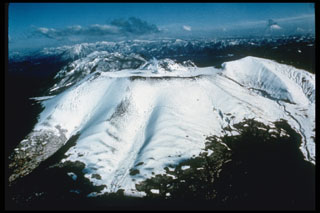Report on Shikotsu (Japan) — April 1981
Scientific Event Alert Network Bulletin, vol. 6, no. 4 (April 1981)
Managing Editor: Lindsay McClelland.
Shikotsu (Japan) Minor ash emission during February seismic peak
Please cite this report as:
Global Volcanism Program, 1981. Report on Shikotsu (Japan) (McClelland, L., ed.). Scientific Event Alert Network Bulletin, 6:4. Smithsonian Institution. https://doi.org/10.5479/si.GVP.SEAN198104-285040
Shikotsu
Japan
42.688°N, 141.38°E; summit elev. 1320 m
All times are local (unless otherwise noted)
Seismicity declined to its usual level of fewer than three recorded earthquakes per day in March and remained at this level through April. Although no volcanic activity apparently had accompanied the peak of seismicity in February (1,211 events), subsequent investigation revealed that a weak steam explosion had occurred on 27 February or a few days earlier.
On the morning of 27 February an All Nippon Airways crew reported that they saw radially darkened snow on the SE part of the summit area. Yoshio Katsui visited the summit on 9 April and found a single layer of gray ash in the snow. The ash layer was only 0.3-0.6 mm thick at the crater rim. The total volume of ejecta was estimated to be no more than 400 m3.
Geological Summary. The 13 x 15 km Shikotsu caldera, largely filled by the waters of Lake Shikotsu, was formed during one of Hokkaido's largest Quaternary eruptions about 31-34,000 years ago. The small andesitic Tarumaesan stratovolcano was then constructed on its SE rim and has been frequently active in historical time. Pyroclastic-flow deposits from Tarumaesan extend nearly to the Pacific coast. Two other Holocene post-caldera volcanoes, Fuppushidake (adjacent to Tarumaesan) and Eniwadake (on the opposite side of the caldera), occur on a line trending NW from Tarumaesan, and were constructed just inside the caldera rim. Minor eruptions took place from the summit of Eniwadake as late as the 17th century. The summit of Tarumaesan contains a small 1.5-km-wide caldera formed during two of Hokkaido's largest historical eruptions, in 1667 and 1739. Tarumaesan is now capped by a flat-topped summit lava dome that formed in 1909.
Information Contacts: JMA, Tokyo; Y. Katsui, Hokkaido Univ.

